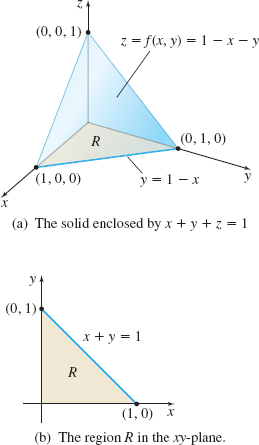EXAMPLE 7Using a Double Integral to Find the Volume of a Solid
Find the volume V of the solid in the first octant enclosed by the plane x+y+z=1.
Solution Figure 21(a) shows the solid in the first octant enclosed by the plane x+y+z=1. The volume V of the solid lies under the plane z=f(x,y)=1−x−y and above the region R in the xy-plane bounded by the lines x=0, y=0, and x+y=1. See Figure 21(b). The region R is x-simple and y-simple. If we treat R as x-simple, then y varies from y=0 to y=1−x, 0≤x≤1. The volume V of the solid is V=∬
